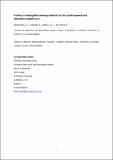Files in this item
Profiles of visuospatial memory dysfunction in opioid exposed and dependent populations
Item metadata
| dc.contributor.author | Baldacchino, A. | |
| dc.contributor.author | Tolomeo, S. | |
| dc.contributor.author | Balfour, David | |
| dc.contributor.author | Matthews, Keith | |
| dc.date.accessioned | 2019-05-19T23:37:50Z | |
| dc.date.available | 2019-05-19T23:37:50Z | |
| dc.date.issued | 2019-05 | |
| dc.identifier | 256162773 | |
| dc.identifier | 32674021-8706-4a81-b9fd-633111d9e288 | |
| dc.identifier | 85056830633 | |
| dc.identifier | 000474921600012 | |
| dc.identifier.citation | Baldacchino , A , Tolomeo , S , Balfour , D & Matthews , K 2019 , ' Profiles of visuospatial memory dysfunction in opioid exposed and dependent populations ' , Psychological Medicine , vol. 49 , no. 7 , pp. 1174-1184 . https://doi.org/10.1017/S0033291718003318 | en |
| dc.identifier.issn | 0033-2917 | |
| dc.identifier.other | ORCID: /0000-0002-5388-7376/work/60196783 | |
| dc.identifier.uri | https://hdl.handle.net/10023/17729 | |
| dc.description.abstract | Background . Chronic opioid exposure is common world-wide, but behavioural performance remains under-investigated. This study aimed to investigate visuospatial memory performance in opioid-exposed and dependent clinical populations and its associations with measures of intelligence and cognitive impulsivity. Methods . We recruited 109 participants: (i) patients with a history of opioid dependence due to chronic heroin use (n = 24), (ii) heroin users stabilised on methadone maintenance treatment (n = 29), (iii) participants with a history of chronic pain and prescribed tramadol and codeine (n = 28) and (iv) healthy controls (n = 28). The neuropsychological tasks from the Cambridge Neuropsychological Test Automated Battery included the Delayed Matching to Sample (DMS), Pattern Recognition Memory, Spatial Recognition Memory, Paired Associate Learning, Spatial Span Task, Spatial Working Memory and Cambridge Gambling Task. Pre-morbid general intelligence was assessed using the National Adult Reading Test. Results . As hypothesised, this study identified the differential effects of chronic heroin and methadone exposures on neuropsychological measures of visuospatial memory (p < 0.01) that were independent of injecting behaviour and dependence status. The study also identified an improvement in DMS performance (specifically at longer delays) when the methadone group was compared with the heroin group and also when the heroin group was stabilised onto methadone. Results identified differential effects of chronic heroin and methadone exposures on various neuropsychological measures of visuospatial memory independently from addiction severity measures, such as injecting behaviour and dependence status. | |
| dc.format.extent | 27 | |
| dc.format.extent | 690335 | |
| dc.language.iso | eng | |
| dc.relation.ispartof | Psychological Medicine | en |
| dc.subject | Codeine | en |
| dc.subject | Cognition | en |
| dc.subject | Heroin | en |
| dc.subject | Methadone | en |
| dc.subject | Opiods | en |
| dc.subject | Tramadol | en |
| dc.subject | Visuospatial memory | en |
| dc.subject | BF Psychology | en |
| dc.subject | RC0321 Neuroscience. Biological psychiatry. Neuropsychiatry | en |
| dc.subject | NDAS | en |
| dc.subject.lcc | BF | en |
| dc.subject.lcc | RC0321 | en |
| dc.title | Profiles of visuospatial memory dysfunction in opioid exposed and dependent populations | en |
| dc.type | Journal article | en |
| dc.contributor.institution | University of St Andrews. Population and Behavioural Science Division | en |
| dc.contributor.institution | University of St Andrews. Centre for Minorities Research (CMR) | en |
| dc.contributor.institution | University of St Andrews. School of Medicine | en |
| dc.identifier.doi | 10.1017/S0033291718003318 | |
| dc.description.status | Peer reviewed | en |
| dc.date.embargoedUntil | 2019-05-20 |
This item appears in the following Collection(s)
Items in the St Andrews Research Repository are protected by copyright, with all rights reserved, unless otherwise indicated.

